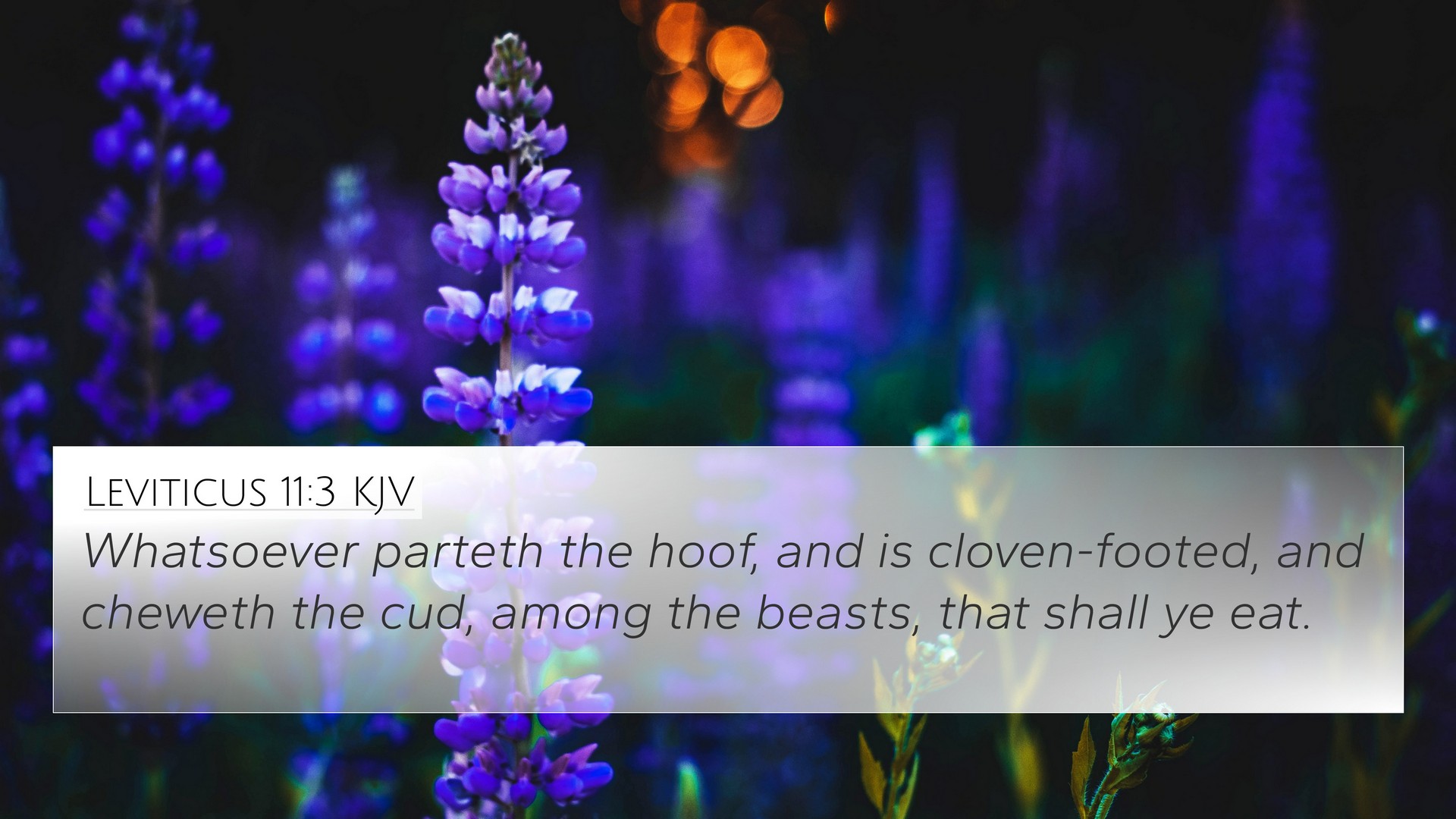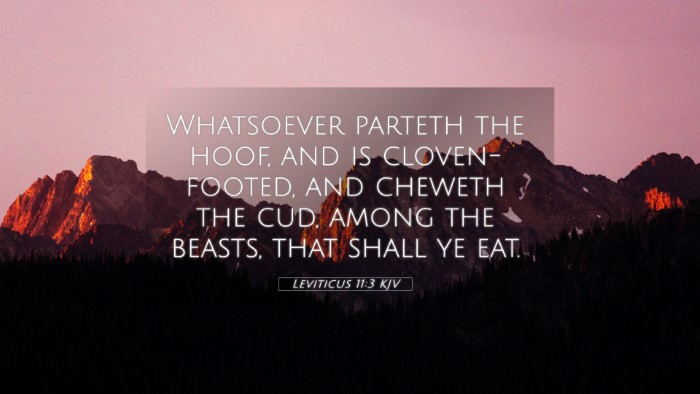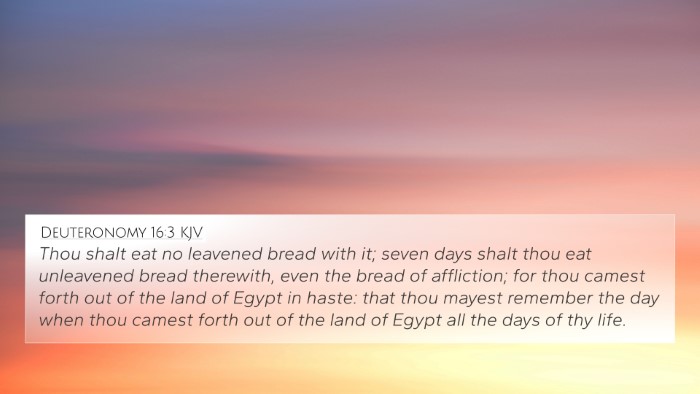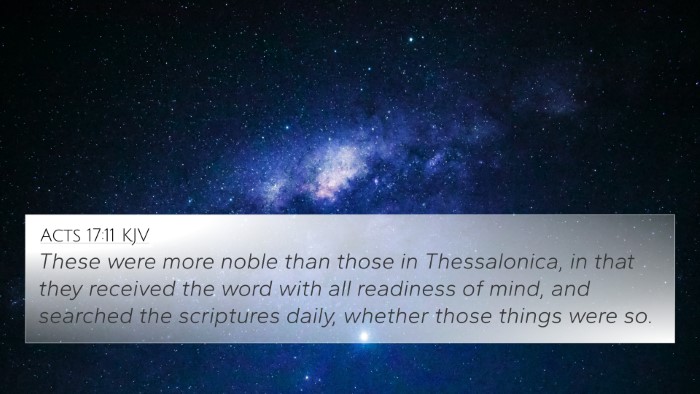Understanding Leviticus 11:3
Verse: "Whatsoever parteth the hoof, and is clovenfooted, and cheweth the cud, among the beasts, that shall ye eat." - Leviticus 11:3
Meaning and Context
The dietary laws presented in Leviticus 11 serve as fundamental guidelines for the Israelites, delineating what is clean and unclean. In this particular verse, God specifies the characteristics of animals that are permissible for consumption, emphasizing a distinction between clean and unclean animals. This verse reflects God’s standards for holiness and purity among His people.
Commentary Insights
Matthew Henry's Commentary
Henry notes that the criteria for clean animals revolve around two main traits: the animal must both chew the cud and have a split hoof. This distinction served both a practical purpose in maintaining health and a spiritual one by placing boundaries around acceptable behavior in worship and daily life, thus teaching obedience to God's law.
Albert Barnes' Notes
Barnes adds that the laws about food are not just about physical health but also stress the importance of spiritual cleanliness. He interprets the concept of 'chewing the cud' as a symbol of meditation and reflection on God's Word, suggesting that eating clean animals also meant engaging in a lifestyle that sought to honor God's commands. The distinction was likely meant to set apart the Israelites from surrounding nations, fostering a unique identity through adherence to these laws.
Adam Clarke's Commentary
Clarke explains that the practice of eating only clean animals was also an act of faith and obedience, reinforcing the relationship between the Israelites and their God. He further discusses that while these dietary restrictions may seem outdated, they establish a principle of living a life in accordance with God’s will, emphasizing the need for separating from practices that could lead to spiritual compromise.
Bible Cross References
- Deuteronomy 14:6: "And every beast that parteth the hoof, and cleaveth the cleft into two claws, and cheweth the cud among the beasts, that shall ye eat."
- Psalms 147:9: "He giveth to the beast his food, and to the young ravens which cry."
- Isaiah 66:17: "They that sanctify themselves, and purify themselves in the gardens behind one tree in the midst, eating swine's flesh, and the abomination, and the mouse, shall be consumed together, saith the Lord."
- Mark 7:19: "Because it entereth not into his heart, but into the belly, and goeth out at the draught. Purging all meats."
- Acts 10:14-15: "But Peter said, Not so, Lord; for I have never eaten any thing that is common or unclean. And the voice spake unto him again the second time, What God hath cleansed, that call not thou common."
- 1 Timothy 4:4-5: "For every creature of God is good, and nothing to be refused, if it be received with thanksgiving: For it is sanctified by the word of God and prayer."
- Revelation 21:27: "And there shall in no wise enter into it any thing that defileth, neither whatsoever worketh abomination, or maketh a lie: but they which are written in the Lamb's book of life."
Thematic Connections
Considering the connections between Bible verses, Leviticus 11:3 significantly relates to broader themes of holiness, obedience, and special covenant between God and His people. The criteria for clean and unclean animals symbolize deeper spiritual truths and reflect the nature of God in guiding His people towards righteousness and community identity.
Practical Implications
The passage not only informs current dietary practices for some religious communities but also serves as a reminder to congregants of the need for spiritual discernment. Understanding clean and unclean can be viewed metaphorically, extending to moral and ethical choices in daily life, urging believers to reflect on their conduct as representatives of God's holiness.
Cross-Referencing Bible Study
For those interested in Bible cross-referencing, tools such as a Bible concordance and a cross-reference Bible study guide can assist in identifying scriptural parallels like those listed above. Engaging in Bible studies that employ a cross-reference system allows believers to explore themes and annotations that resonate across Scriptures.
Learning to find cross-references in the Bible enhances one's understanding of God's message as a cohesive narrative. This method reveals how various books and verses interact, highlighting God's consistent themes and teachings throughout the scriptures.











